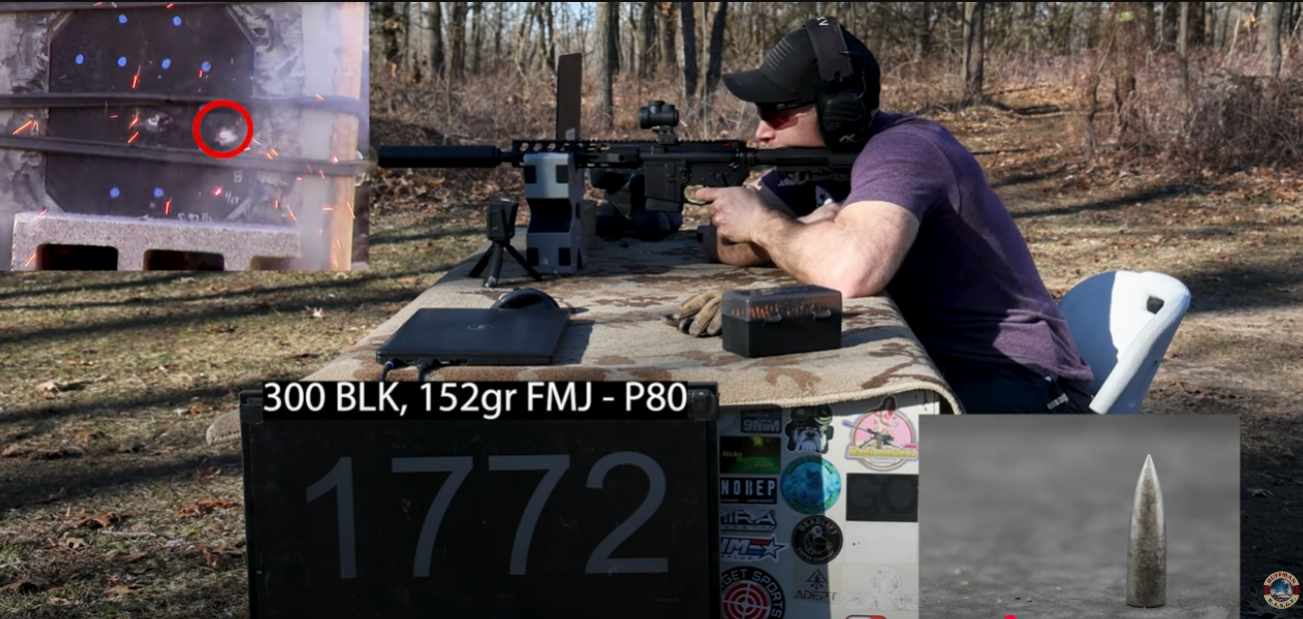Matt aka Buffman has released yet another range day torture test of Chase AR1000 Steel Body Armor
In this video he goes way into detail to provide some important info on just what kind of protection you can expect.
Matt, also known as “the king of armor destruction,” introduces a body armor demo sponsored by Chase Tactical, featuring the AR1000 NIJ certified Level III/III+ steel plates. He provides an overview of the plates’ features, including their weight (5.945 pounds), thickness (6.86 mm), and use of abrasion-resistant steel. Matt mentions that the plates have an anti-spall coating and discuss their dimensions and cut design. He notes the importance of testing armor under “worst-case scenario” conditions, including shooting from zero degrees at 45 feet.
The armor is tested with various threats, and Matt emphasizes that his tests may not align with official NIJ standards since he’s testing on a budget. He also explains the clay setup used for backface deformation testing and introduces the tools (like chronographs) used for testing bullet velocity. Matt mentions the NIJ certification process and clarifies that his tests are not official certifications. He further explains the significance of buying directly from the manufacturer to avoid overpriced products and hints at upcoming tests for the armor’s performance.
Matt continues testing the AR1000 armor plates, focusing on the backface deformation and performance. He observes that after the first two shots, the plate shows minimal deformation with no penetration. The worst dimple measured 37mm, which is within acceptable limits for NIJ standards. Despite some strap damage due to steel fragmentation, no pass-throughs occur.
As the testing progresses, Matt increases the number of shots on the second plate to eight, still using the M80 ball. The plate shows some fragmentation damage to the Rhino coating but still prevents penetration, with minimal deformation in the clay. He notes that the plate is absorbing significant muzzle energy, causing it to lose its original curve, which is a sign of effective energy absorption.
Next, Matt tests the plate beyond NIJ spec using the V50 rating, which indicates the velocity at which 50% of shots will penetrate. Using a Savage 110 Tactical, he fires six rounds of M80 ball at velocities exceeding NIJ standards, confirming that the plate still stops the projectiles with no penetration. He highlights that despite the high energy, the plate’s steel alloy holds up well, avoiding cracking.
Finally, Matt prepares for testing with the M855 5.56 NATO round, which is rated for RF1 and RF2 by NIJ at 3115 feet per second.
Matt continues testing the AR1000 steel armor plates with various rounds, starting with the M855A1 and different barrel lengths. The 16-inch barrel was able to penetrate the plate, while the 22-inch barrel made three pass-throughs. Matt notes that in real-world situations, the plates would likely still stop the M855A1 round, especially with the 16-inch barrel, but some fragmentation issues are present due to the thin Rhino coating. Despite this, the plate performs well, with HICOM’s steel alloy impressively holding up against high muzzle energy.
Next, Matt tests the plate with the 5.45x39mm Russian caliber, including three types of rounds: the standard 7N6, the modernized 7N6M, and the Norma 62-grain steel penetrator. He uses an SSG82 rifle with a 23.75-inch barrel and finds no penetrations from any of the rounds. He compares this to the earlier M855A1 test, confirming the steel performs well against 5.45 threats.
Matt then moves on to the .300 Blackout and armor-piercing rounds, including M2 armor-piercing, P80 Black tip, and M80A1 Enhanced Performance Round (EPR). Using a 10.5-inch SBR, he tests these rounds but notes that the steel plate successfully prevents penetration.
Finally, Matt tests the new Sig Sauer 6.8x51mm/.277 Fury round, used in the U.S. Army’s XM7 rifle. He uses a 16-inch barrel with a suppressor and tests with both reduced range ammo (113 grains) and the Gen 1 1186 round. The 1186 EPR round successfully penetrates the plate, creating two clean holes, but it does not penetrate the second plate behind it. Matt highlights that this is the first time the 1186 has been tested on camera.
Matt wraps up his testing by taking two shots at extended range (100 yards) with the 1186 GP and M2 armor-piercing (M2AP) rounds. While the hit probability is lower at this distance, he manages to make two solid hits on the plate with the 1186 round. He tests these rounds on a 24-inch Bear Creek Arsenal BC-8 with NIJ-spec loads, and while the rounds perform within spec, the steel plate cracks when hit with the M2AP at range. The crack causes some penetration, showing the brittleness of the steel under extreme stress.
Despite these cracks, Matt is impressed by the plate’s performance overall. It successfully handles most of the threats, including 5.56 rounds, without cracking, and it’s capable of stopping many threats without significant issues. Only the M2AP rounds, when fired at extended range, manage to penetrate the steel. He notes that M855A1 remains a threat for personal body armor at close range, but once distances increase, the plate holds up.
He wraps up the video by acknowledging the limitations of his test due to a lack of available rounds like the M80A1 and noting that, with more testing, it would be interesting to see how other rounds fare against the plates.
Matt takes a moment to thank those who supported the video, including his family, Patreon and YouTube members, War Pig Armory for supplying the rounds, Chase Tactical for providing the Hi-Com AR1000 plates, and Tactical Shit for their continued support.





